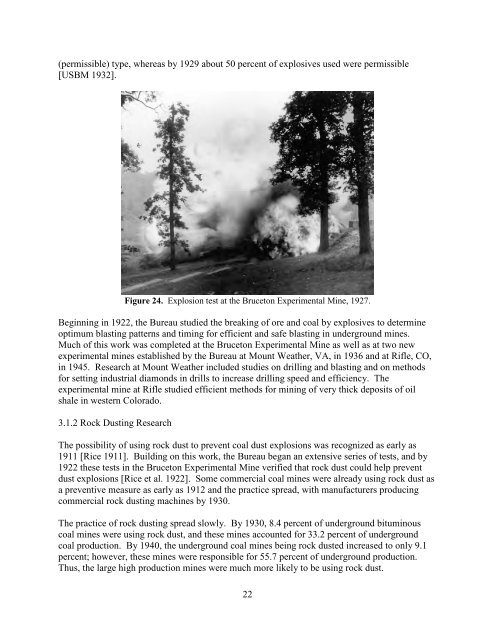One Hundred Years of Federal Mining Safety and Health Research
One Hundred Years of Federal Mining Safety and Health Research
One Hundred Years of Federal Mining Safety and Health Research
- No tags were found...
You also want an ePaper? Increase the reach of your titles
YUMPU automatically turns print PDFs into web optimized ePapers that Google loves.
(permissible) type, whereas by 1929 about 50 percent <strong>of</strong> explosives used were permissible<br />
[USBM 1932].<br />
Figure 24. Explosion test at the Bruceton Experimental Mine, 1927.<br />
Beginning in 1922, the Bureau studied the breaking <strong>of</strong> ore <strong>and</strong> coal by explosives to determine<br />
optimum blasting patterns <strong>and</strong> timing for efficient <strong>and</strong> safe blasting in underground mines.<br />
Much <strong>of</strong> this work was completed at the Bruceton Experimental Mine as well as at two new<br />
experimental mines established by the Bureau at Mount Weather, VA, in 1936 <strong>and</strong> at Rifle, CO,<br />
in 1945. <strong>Research</strong> at Mount Weather included studies on drilling <strong>and</strong> blasting <strong>and</strong> on methods<br />
for setting industrial diamonds in drills to increase drilling speed <strong>and</strong> efficiency. The<br />
experimental mine at Rifle studied efficient methods for mining <strong>of</strong> very thick deposits <strong>of</strong> oil<br />
shale in western Colorado.<br />
3.1.2 Rock Dusting <strong>Research</strong><br />
The possibility <strong>of</strong> using rock dust to prevent coal dust explosions was recognized as early as<br />
1911 [Rice 1911]. Building on this work, the Bureau began an extensive series <strong>of</strong> tests, <strong>and</strong> by<br />
1922 these tests in the Bruceton Experimental Mine verified that rock dust could help prevent<br />
dust explosions [Rice et al. 1922]. Some commercial coal mines were already using rock dust as<br />
a preventive measure as early as 1912 <strong>and</strong> the practice spread, with manufacturers producing<br />
commercial rock dusting machines by 1930.<br />
The practice <strong>of</strong> rock dusting spread slowly. By 1930, 8.4 percent <strong>of</strong> underground bituminous<br />
coal mines were using rock dust, <strong>and</strong> these mines accounted for 33.2 percent <strong>of</strong> underground<br />
coal production. By 1940, the underground coal mines being rock dusted increased to only 9.1<br />
percent; however, these mines were responsible for 55.7 percent <strong>of</strong> underground production.<br />
Thus, the large high production mines were much more likely to be using rock dust.<br />
22
















